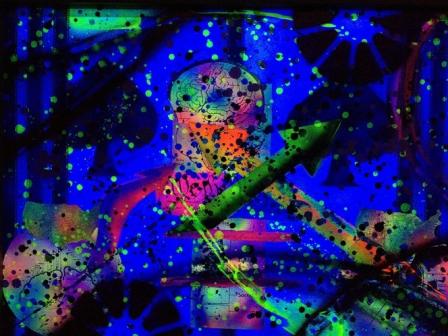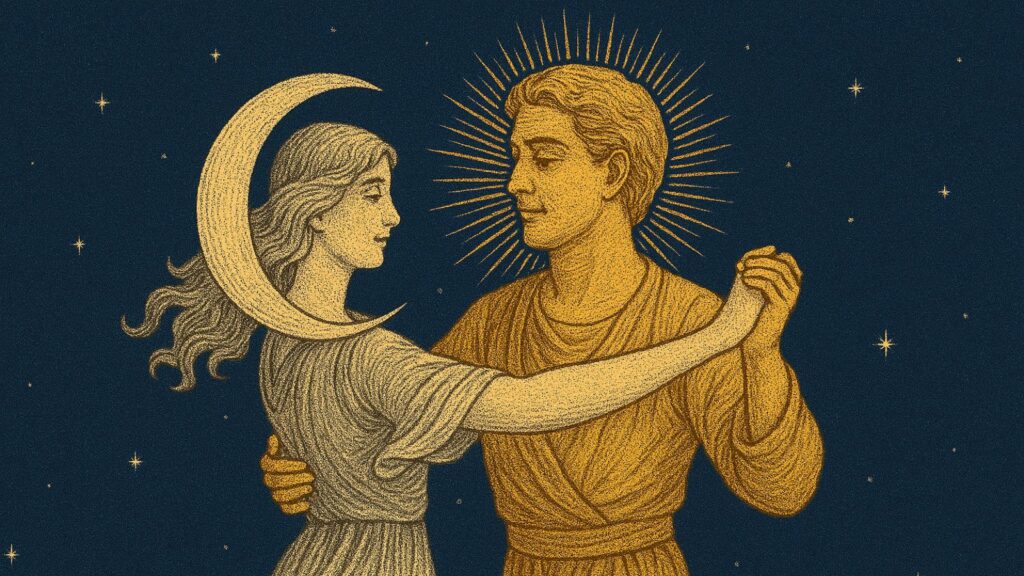Rammellzee is a military function formation… I am ramming the knowledge to an elevation and I am understanding the knowledge behind the Zee. Since we are dealing with Roman letters, we have to go back to the day when the Romans were using the ram to break down doors. Our situation today is to break down a door of knowledge hidden behind society. We're going to work our way around it instead of breaking it straight up. Whereas before you'd be trying to break through and you would be on the bottom of the pile. We're talking about where graffiti originated, where hardcore war went down, with markers against markers and letters against letters. You think war is always shooting and beating everybody up, but no, we had the letters fight for us.
Upon first encounter, the name Rammellzee is confusing to most, because that ordering of syllables isn't found in English, nor any other language in existence. In fact, RAMM:ELL:ZEE is not the name of a legendary graffiti artist, but an equation which the man who bears it is "performing." The nature of this equation is enigmatic, but it has to do with declaring war on the conventional alphabet – composed of phonemes, syllables, prefixes, suffixes, etc. – to deconstruct that alphabet, and use its components to build mutated, alien forms. No wonder it's confusing to most – the RAMM-?LL-Z?? (as it’s properly written) is the living equation that points a way beyond the deadlock of contemporary culture. For me, something clicked just from reading the name of this iconic equation with no other context. It had more in common with a hieroglyphic image than a series of semantic signifiers. The form and function, the how and the why, the medium and the message, the package and its contents – these were collapsed, and what emerged was a name that was a three-dimensional energy form that can be seen and grasped, not merely understood. Terence McKenna was on to a similar idea when he imagined the very real possibility of telepathy: not the transmission of thoughts like emails, but the manifestation of them in holographic form through the synesthesia of sound and texture.
Perhaps it is also the “step outside philosophy” imagined by the notoriously cryptic French philosoper Jacques Derrida, a reclamation of the word from the hands of technoscience, hierarchy, progress, and any narrative which impresses upon people the absurd notion that one needs a certain level of expertise before they can make true utterances. We might interpret Derrida’s phrase to mean that the institution of philosophy is both the main obstacle and the only chance of survival for the idea of philosophy. Institutionalized, it becomes ensnared in technoscience's narrative of modernity and progress, subject to the ebbs and flows of competing interests in a climate of sleazy desperation. "The greatest story ever told" but one that is just that – a myth.
The iconic equation RAMMELLZEE bombs the structures of the sneering hierarchy and levels the playing field, affirming truth as immanent in every moment and materializable through language. "The street urbanism portrayed through these disciplines, combined with his mythology, transcends and ascends all time periods that have indulged and performed “FUTURES." Ramm's claim is to have dislodged language from history and used it to express a future – not the future, but a future. Not that which was fated to happen, but that which might have been, depending on the decisions of free individuals and their discipline. Rammellzee: "To wipe out a language is hard! I know of no one yet that has done that. I only weapon slave the Ikons we all know." His project was radical yet astonishingly pragmatic: the erasure of the historical residue attached to words and letters in order to restore to them their original potency as the literal constitutive building blocks of reality itself.
We failed what could have been 'our culture.' Writing for fame or name is a poor excuse to be a monk and is the reason why this culture is a subculture. I went [to an auction] in 2000. Everyone who was anyone in this 'subculture' had works for sale. No one sold except for a few. I felt that the 'culture' died right there. There was too much mannerism, not enough 'burner'! Our futurism! We should have stuck to our principles, left by the monks. We should have only stuck to doing 'the letter' and joined together to fight the light dwellers, but we will always be 'Kings from the Dark Continent'. It's hard to become a real live painting in B-boy style but I managed, and we all could have managed."
Ramm realized that his peers, rather than sticking to principles and “doing the letter,” had caved to commercial interests. From that point onward, Rammellzee began his obsessional pursuit which resulted in the creation of hundreds of paintings, sculptures, music (“sound sculptures”), performances and written manifestos, carrying to its logical conclusion the culture which had borne him thus far. His influence cannot be overstated. In a time when historical sparks were flying, he was always in the right place at the right time. Founding and elaborating the principles of Wildstyle graffiti one day, and contributing his voice to the foundational rap track “Beat Bop” the next, there is literally no facet of hip hop culture – today a worldwide phenomenon and billion-dollar industry – that Rammellzee did not lay his fingers on.
From this alternative perspective, the role of the savage, graffiti-inspired artist Jean Michel-Basquiat, a peer of Rammellzee and part of the same NYC hip hop/graffiti scene, is transformed. The arrival of his works at the auctions of Sotheby’s does not represent street art’s culminating moment of finally producing an artist good enough to make it on the global stage, but a retreat in which the full consequences of street art were repressed and re-appropriated by a pathological, disease culture. Basquiat’s celebratory reception as a kind of art-world savior then takes on a sinister undertone, as it should, when one reflects upon the fact that such vastly inflated adulation hastened him toward an early grave. We should take note here of pointed irony that the artist who holds the distinction of producing the most expensive painting ever sold – ‘Dustheads’, for $48.8 Million – took direct inspiration from an art form that, because of its illegality, usually comes at a hefty cost to the artist in the form of fines and/or imprisonment. This absurd pricing can only be read as a defense mechanism, a way to appropriate, resist and recuperate street art’s subversive potential.
What, then, is its future, its unfulfilled potential? Some contemporary phenomena suggest possible directions. After the fall of the Iron Curtain and the reunification of Germany, the largest remaining fragment of the Berlin Wall was converted into a “gallery,” with each panel of the wall portraying a different image, usually replete with the themes of the “post-ideological” 90s era: tolerance, diversity and unity are the buzzwords here. We should not overlook the political dimensions of placing such a mural on this particular monument. In these images, the motif of the destruction of the walls separating people is constantly invoked; the wall’s destruction is represented triumphantly, as the end of the separation between people and the beginning of a new Utopian age. The viewer is solicited, in so many guises, by a utopic global vision invariably featuring people of many colors and cultures holding hands, a vision which is then often opposed to a grand depiction of the horrors and cruelty of contemporary society. One enigmatic piece, for example, shows a vast factory in which the naked bodies of women are either being produced or ground into bits, while, nearby, men and women in fancy suits with forks spearing sausages sticking out of their heads turn away.
Consider also the ubiquity of street art murals in impoverished immigrant neighborhoods throughout the world, often placed on the underpasses of highways that cut through the neighborhood. In such decrepit parts of cities, usually subject to industrial exploitation and bereft of social infrastructure, the street art becomes a placeholder for the unrealized and unrealizable dreams of the neighborhood, borough or city. In an attempt to describe and analyze this phenomenon, the Atlanta-based art critics Cinque Hicks, Katherine Fox and Jamie Cullum developed the concept of “noplaceness” to describe the breed of modern metropolises which are diffuse and ahistorical, built at a time when the world was held in the thrall of the techno-utopian dream. In these centerless “noplaces,” street art offers the facade of a portal into an escape from the dreariness of modern social space. We should bear in mind the prodigious role the New York City Wildstyle graffiti scene played in formulating this model and popularizing it to the point that it became a global phenomenon, visible in every urban dwelling throughout the world.
However, I want to suggest that in the passage from 1980s NYC wildstyle to the contemporary East-Side Gallery in Berlin, something was lost in the mix. One needs only to look at the name. While being street art, it still goes under the moniker of gallery. The works are sanctioned – they occupy the wall legally, and the wall has no other purpose but to display the art. As such, the works are unchanging, and at the bottom of each painting, one can recognize an insignia bearing the date of the painting’s restoration – 1999 – 2009. In a post-9/11 world, the innocence of these unchanging paeans to globalization is lost. What is needed is the sense of urgency and militancy that was present among Rammellzee and his peers who were "doing the letter."
Ramm’s philosophy makes no obfuscation of the warfare that he and other burner artists were engaged in:
This is symbolic wars using slang and ionics to understand the very outline-structure that makes A through Z its mathematics and science for disease-culture to understand the consequences of structure that have been disease-culturally sabotaged and trick-knowledged.
One should read carefully this very precise statement from Ramm’s magnum opus, the Ionic treatise Gothic Futurism assassin knowledges of the remanipulated square point's one to 720° to 1440°. The outline-structure is nothing more than Rammellzee’s own term for the current historical superstructure. Sometimes it is termed modernity, sometimes postmodernity; in this case, simply the “system” or the “structure” will suffice. The outline-structure is the set of instructions for society at the highest of levels, the metaprogramming that is scarcely recognizable to those used to working within the code, at the nuts-and-bolts level. According to Ramm, “A through Z,” originally unruly elements within the system which represented a radical openness and possibility, have been tamed and domesticated, made into “mathematics and science for disease culture.”
Rammellzee’s project compels us to a deeper inspection of the nature of language, down to the letters themselves. One first begins to relate to language, and hence the world and identity, through those mysterious, almost mystical configurations of lines and curves that we call letters. To an infant, before an A is an A, it is a totem-like object, unrestrained in its capacity to symbolize and portend, something like an entity in an animist cosmology. The infant knows instinctively that there is some significance in the letter formation, but it can’t figure out what it is. To become culturally adjusted, one largely needs to forget this gap, to look past it. Ramm’s entire project was the recuperation and remembrance of this forgetting, as he evinced in so many forms.
In his slanguage, Rammellzee performs cut-ups in the Burroughsian-style, although he derives inspiration not from surrealistic experiments, but freestyle rapping. One should note here that recent brain studies have shown that freestyle rappers engaged in a flow experience have “a unique functional reallocation of brain activity in the prefrontal cortex,” leading these scientists to suggest “a novel neural network that appears to be intimately involved in improvisatory and creative endeavors.” Compare these findings with the idea constantly thematized by seminal comic book author Alan Moore: “When you start messing around with language itself, language is pretty much reality, it’s how we construct the entire of our reality, so if you start playing around with it, it gets very odd.” This alternative neural networking that occurs when we find ourselves creating in real time is none other than hyperspace, one in the very same with psychedelic reality, “trip space.” Burroughs, in interviews throughout his life, stressed again and again that states reached while under the influence of psychedelics could be re-visited by the sober mind from that point forward.
However, in the fictional worlds Moore creates, such as V for Vendetta or Watchmen, he remains at the level of replicating existing systems of symbolic fiction. Rammellzee is, I would argue, more effective, and more radical, in bypassing this level altogether and elevating the structure of the letter itself into its own argument. Dispensing with the epi-phenomena of phonemic and semantic value, the letters thus reveal their inherent logic, a logic of mathematical precision.
This was the logic that gave force to the original burner movement – the logic that made a moving page so stunning as it pulled into the platform in an explosion of pure style, wild and confrontational. Today, one can say that graffiti has returned to using the letter merely as a means to transmit some message, often some humanistic propaganda or ideological manipulation as seen in the cases described earlier. But it wasn’t always that way. The original burner graffiti was, above-all vicious, cryptic and hyper-complex, like a piece of alien technology or a psychedelic vision, not making any concessions to accessibility. Ramm’s wager is that it didn’t just look that way, it was that way. In the savage glyphs that began to appear on the surfaces of modern industrial, consumerist “noplaces,” Rammellzee recognized a prophetic message. They told of the mental and spiritual war that would soon fall upon the inhabitants of the planet – and how to fight it. His weaponizing of the letters – both figuratively and literally – was a measure to prevent the spread of the disease culture, Capitalism, Kali Yuga, the Matrix, the System, and point the way forward toward a new one.
You can have four alternatives to human nature – genocide, plain old socialism like bees and ants have, love and dictatorship, which is what we have now, or you can have a lot of high powered mega-structured knowledge where everything becomes not a socialistic bee-type state but a militant state with megastructures. That's the way it should be – mass thinking, mass brain power as one.
– Rammellzee













